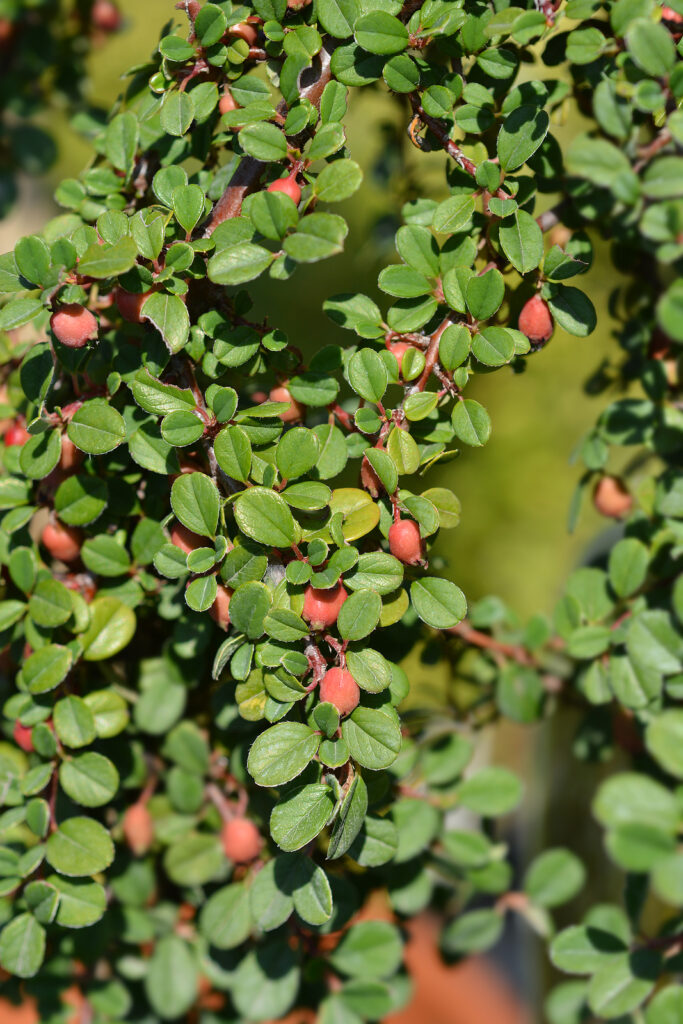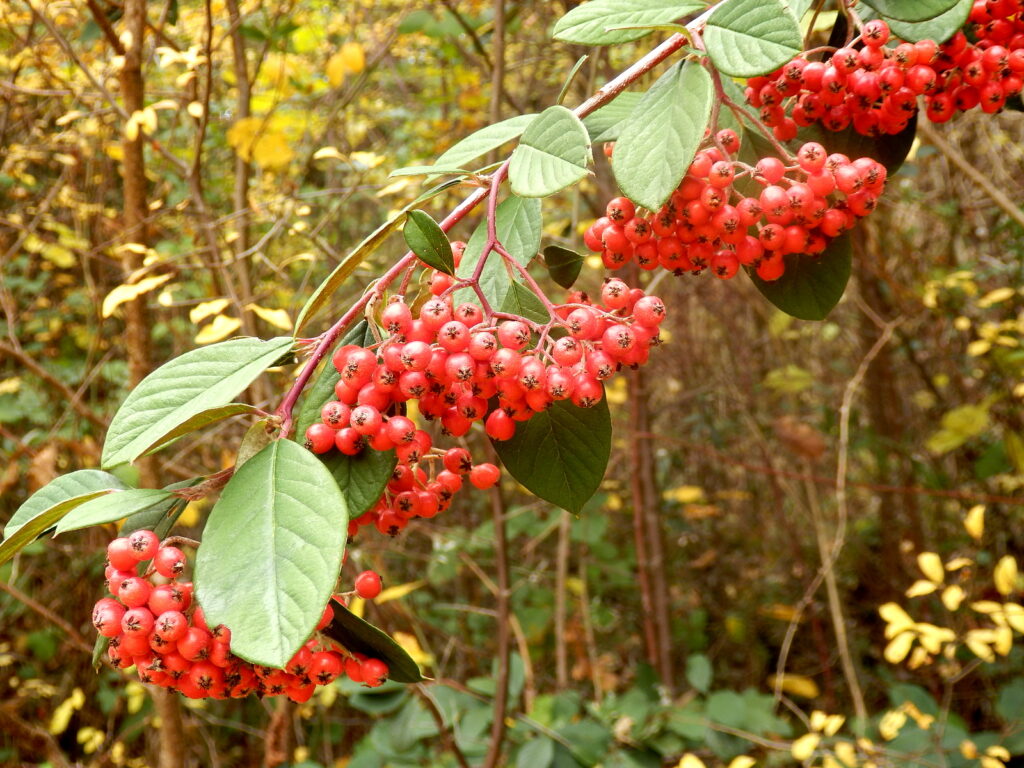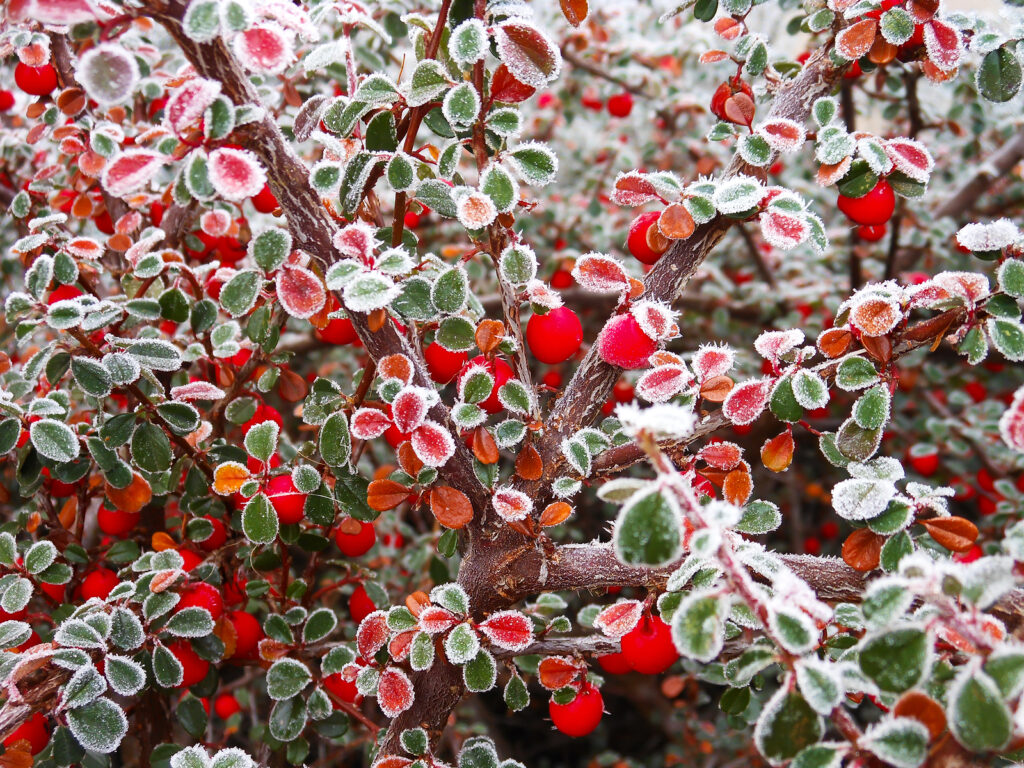Cotoneaster is a genus of more than 200 deciduous to evergreen shrubs and small trees. Cotoneasters bear small white or pinkish flowers in late spring or summer, but they are mainly grown for their attractive branching pattern and small red to black fruits that follow the flowers in autumn and mostly remain on the plant through winter.
Members of this genus range in size from low growers used as groundcovers to tall growing shrubs and small trees to 18 feet (9.4m) in height. Cotoneaster shrubs have a fountain-like form with graceful arching branches. Cotoneasters look best when allowed to maintain their natural form.
Shrub varieties that are especially attractive are Cotoneaster congestus and Cotoneaster horizontalis. Those with long-lasting fruit are Cotoneaster franchetti and Cotoneaster microphyllus.
All cotoneasters grow vigorously and thrive will little or no maintenance. Pruning away old and dead wood will keep the plant healthy. Cotoneasters can tolerate poor soil and drought.

Get to know Cotoneaster
- Plant type: Evergreen, semi-evergreen, and deciduous shrubs
- Growing zones and range: Zones 5-9
- Hardiness: Hardy to Zone 5
- Height and width: 12 inches (30cm) to 18 feet (9.4m)
- Flowers: Small white or pinkish flowers resemble tiny single roses; they are pretty because of their abundance.
- Berries: Berries follow flowers; berries offer fall and winter color; berries are red or orange.
- Bloom time: Spring or summer depending on the variety
- Uses: Hedges, specimen of interest, groundcover
- Common name: Cotoneaster
- Botanical name: Cotoneaster
- Family name: Rosaceae
Where to plant Cotoneaster
- Plant cotoneaster in full sun or partial shade. Evergreens will tolerate shade but will not flower or fruit as heavily.
- Grow cotoneaster in average garden soil.
- Don’t plant cotoneaster near walkways or driveways; they will likely require frequent pruning.
- Give cotoneaster room to grow.

When to plant Cotoneaster
- Container grown cotoneaster is best set in the garden in spring or autumn; avoid setting out container-grown plants in summer heat.
- Cotoneaster can be started by seed, layering, and cuttings; see Propagation below for details and time of year.
Planting and spacing Cotoneaster
- Space cotoneaster according to the height and spread of the variety you are growing—as close as 3 to 6 feet (.9m-1.8) apart for low-growing groundcover varieties to 18 feet (9.4m) apart for tall-growing shrub varieties.
- Cotoneaster branches can become long and arching; give them room to show off their form.

How to water and feed Cotoneaster
- Water newly planted cotoneaster until it becomes established. Established plants are drought tolerant.
- Fertilize cotoneaster with an even, all-purpose fertilizer in spring and in mid-summer.
Cotoneaster care
- Mulch around plants to conserve soil moisture.
- Prune cotoneaster to enhance arching branches. Keep medium growers looking young by pruning out a portion of old wood each year.
- Prune groundcover varieties to remove dead or awkward branches.
- In mild-winter regions, cotoneaster will be a vigorous grower and can become invasive, spreading by self-layering. Control plants that begin to spread.

Cotoneaster pests and diseases
- Cotoneaster may be attacked by lace buds.
- Cotoneaster is susceptible to fire blight which can cause cankers to form at the base of shoots.
Cotoneaster propagation
- Seeds can be sown when ripe or stored for up to one year in a cool, dry place.
- Cotoneaster can be propagated by soil-layering; anchor an arching branch in the soil in spring to allow it to root.
- Cotoneaster can be propagated by semi-hardshoot cutting in summer or by leafless hardwood cutting in fall.

Cotoneaster varieties to grow
- Cotoneasterd adpressus, creeping cotoneaster. Deciduous, compact species with a stiff habit to 18 inches (45cm) tall and spreading to 6 feet (1.8m) wide. Leaves turn red in fall. Adapted to seaside conditions.
- C. apiculatus, cranberry cotoneaster. Deciduous low and spreading shrub to 36 inches (91cm) tall and 8 feet (2.4m) wide. Leaves turn red or bronze-purple in fall. Berries hold in winter.
- C. congestus, Pyrenees cotoneaster. Evergreen, slow-growing to 3 feet (.9m) tall with dense downward curving branches
- C. dammeri, bearberry cotoneaster. Evergreen shrub grows 8- to 12-feet (2.4-3.6m) tall is fast growing.
- C. divaricatus, spreading cotoneaster. Deciduous shrub grows 6 to 8 feet (1.8-2.4m) tall with wider spread. Dark, glossy leaves; berries turn orange to red in fall.
- C. franchettii. Evergreen with narrow habit to 10 feet (3m) tall; flowers are pinkish followed by orange-red fruit.
- C. horizontalis, rockspray cotoneaster. Deciduous, spreading shrub to 3 feet (.9m) tall and about 6 feet (1.8m) wide; strong herringbone pattern. Leaves turn red in fall and persist in winter. Prone to fire blight.
- C. lacteus (C. parneyi), Parney cotoneaster. Evergreen with graceful arching branches 6 to 10 feet (1.8-3m) tall. White flowers followed by abundant fruit.
- C. linearifolus, thyme-leaf cotoneaster. Dwarf to prostrate groundcover.
- C. lucidus, hedge cotoneaster. Deciduous shrub grows 6 to 10 feet (1.8-3m) tall and wide. Pinkish-white flowers; yellow and red autumn foliage; blue-black fruit.
- C. microphyllus, rockspray cotoneaster. Horizontal branches trail and root to 6 feet (1.8m) and secondary branches grow to 3 feet (.9m). Small leaves with rolled edges. Use in rock gardens.
- C. multiflorus, many-flowered cotoneaster. Deciduous, fountain-like shrub grows to 15 feet (4.5m) tall and wide with arching branches. Showy white flowers followed by red fruits.
- C. perpusillus, also listed as C. horizontalis var. perpusillus. Low growing groundcover. Red leaves and orange fruits in fall
- C. procumbens, also listed as C. dammeri; see above.
- C. salicifolius, willow-leaved cotoneaster. Spreading and arching evergreen grows 10 to 15 feet (3-4.5m) tall with bright red fruit. ‘Emerald Carpet’ is a low-growing cultivar.















